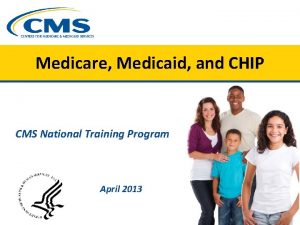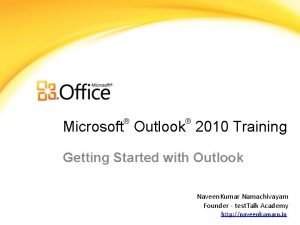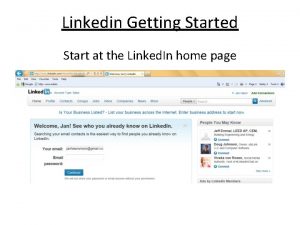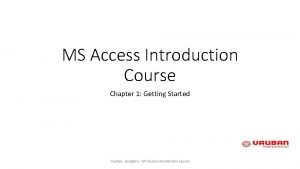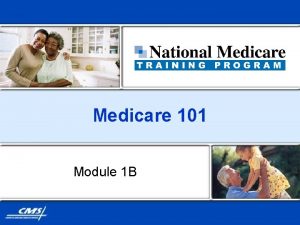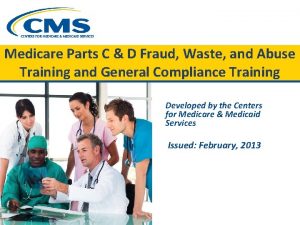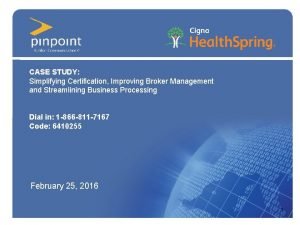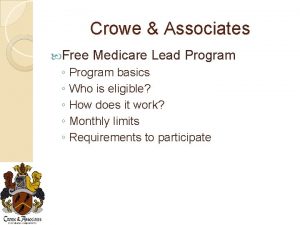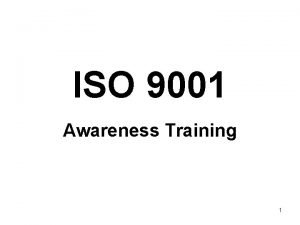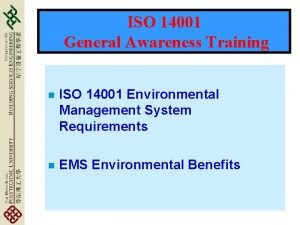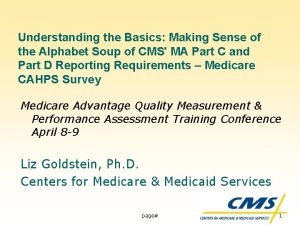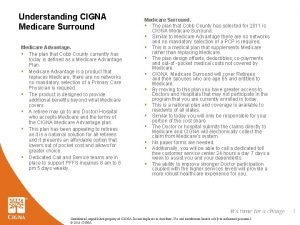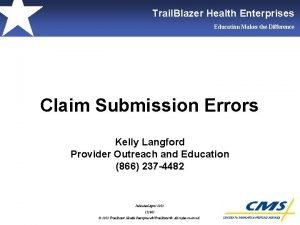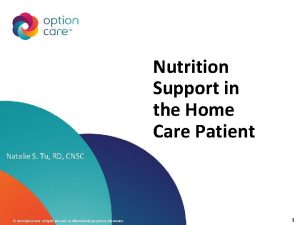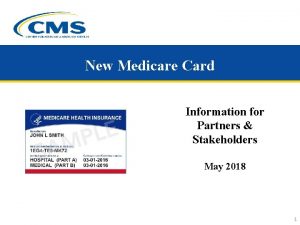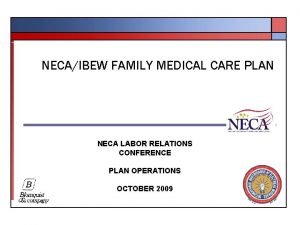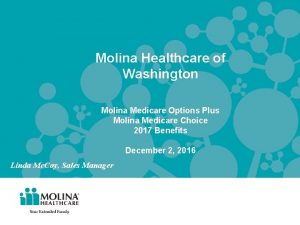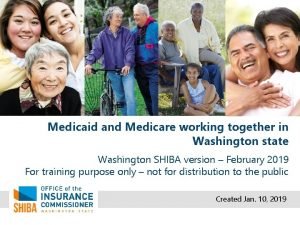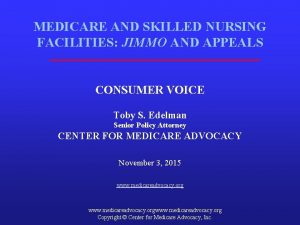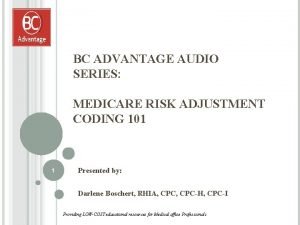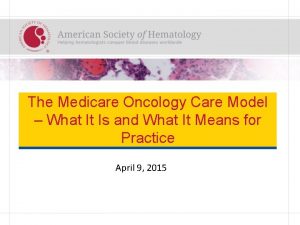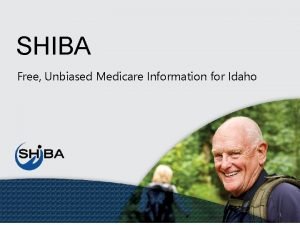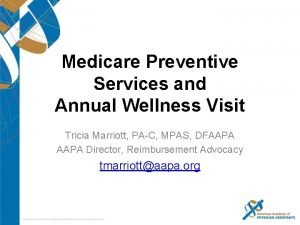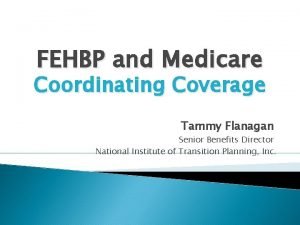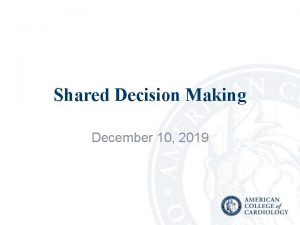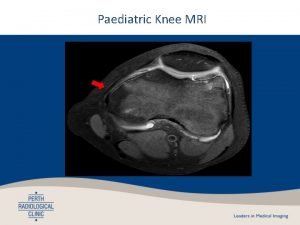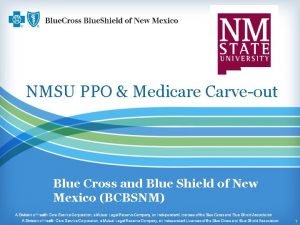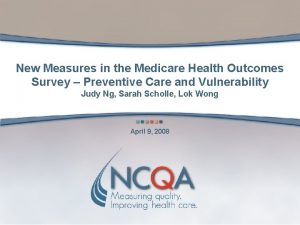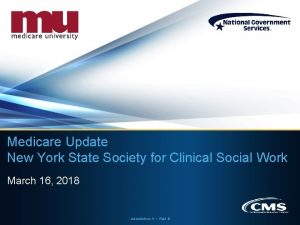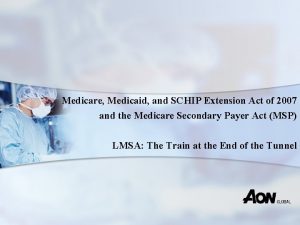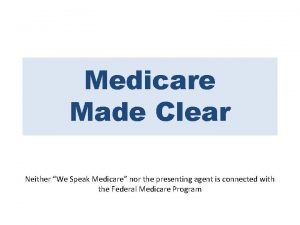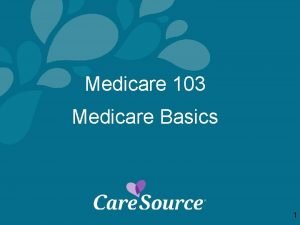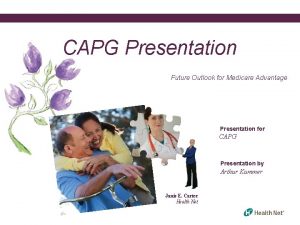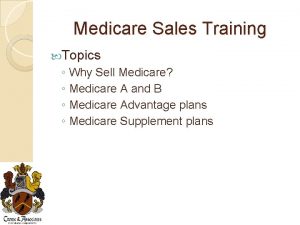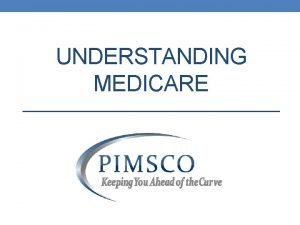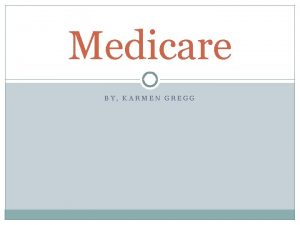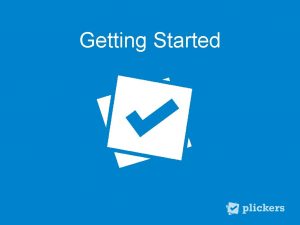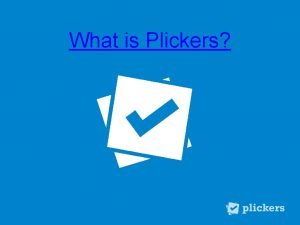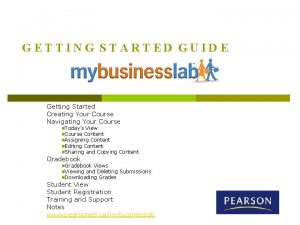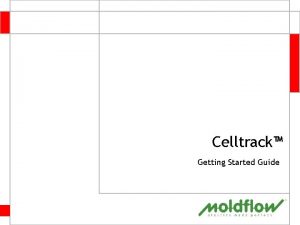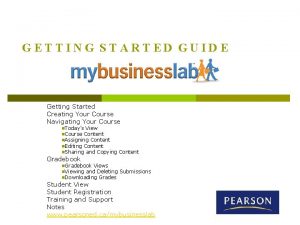2015 National Training Program Medicare Getting Started With
































































- Slides: 64

2015 National Training Program Medicare Getting Started With an Introduction to the Federally-facilitated Health Insurance Marketplace, Medicaid and related resources

What Is Medicare? § Health insurance for people • 65 and older • Under 65 with certain disabilities q Amyotrophic Lateral Sclerosis • Any age with End-Stage Renal Disease NOTE: To get Part A and/or Part B, you must be a U. S. citizen or lawfully present in the United States. December 2015 Medicare Getting Started 2

Who Runs Medicare? § Centers for Medicare & Medicaid Services (CMS) • Administers program § Social Security Administration (SSA) • Enrolls most individuals § Railroad Retirement Board (RRB) enrolls railroad retirees December 2015 Medicare Getting Started 3

The 4 Parts of Medicare Part A Hospital Insurance Part B Medical Insurance Part C Medicare Advantage Plans (like HMOs/PPOs) Includes Part A, Part B and sometimes Part D coverage December 2015 Medicare Getting Started Part D Medicare Prescription Drug Coverage 4

Your Medicare Coverage Choices Original Medicare Part A Hospital Insurance or Medicare Advantage Plan Part C Combines Part A and Part B Medical Insurance May include, or you may be able to add You can add Medicare Supplement Insurance (Medigap) Policy December 2015 Part D Prescription Drug Coverage Medicare Getting Started Part D Prescription Drug Coverage (Most Part C plans cover prescription drugs. You may be able to add drug coverage to some plan types if not already included. ) 5

Enrolling in Medicare—Automatic § Automatic enrollment for those receiving • Social Security benefits • Railroad Retirement Board benefits § Initial Enrollment Period Package • Mailed 3 months before q 65 or q 25 th month of disability benefits • Includes your Medicare card December 2015 Medicare Getting Started 6

Medicare Card § Keep it and accept Medicare Part A and Part B § Return it to refuse Part B • Follow instructions on back of card Back Front Jane Doe December 2015 Medicare Getting Started 7

Enrolling in Medicare When It’s Not Automatic § If you’re not automatically enrolled • You need to enroll with Social Security q Visit socialsecurity. gov, or q Call 1 -800 -772 -1213, or q Visit your local office • If retired from Railroad, enroll with the Railroad Retirement Board (RRB) q Call your local RRB office or 1‑ 877‑ 772‑ 5772 December 2015 Medicare Getting Started 8

When to Enroll in Medicare § Your Initial Enrollment Period (IEP) lasts 7 months • Begins 3 months before your 65 th birthday • Includes the month you turn 65 • Ends 3 months after you turn 65 q Your start date will be delayed § Can enroll in free Part A anytime after IEP begins § Can only enroll in Part B (and premium Part A) during IEP and other limited times § May have a lifetime penalty if you don't enroll during IEP December 2015 Medicare Getting Started 9

More About Enrolling During Your Initial Enrollment Period (IEP) § You can first enroll in Part B (and premium Part A) during your IEP § Must pay a monthly premium for coverage § Your coverage starts based on when you enroll: • Enroll before the month you turn 65, your coverage starts the month you turn 65 • Enroll the month you turn 65, your coverage starts the next month • Enroll the last 3 months of your IEP, your coverage won’t start for 2 to 3 months NOTE: If you're eligible for premium free Part A, you can enroll in Part A any time after your IEP starts December 2015 Medicare Getting Started 10

Enrolling During the General Enrollment Period (GEP) § GEP • For people who didn’t sign up for Part B (or premium Part A) during Initial Enrollment Period § Occurs January 1 through March 31 annually § Coverage starts July 1 § May have to pay a lifetime penalty • 10% for each 12 months eligible but not enrolled December 2015 Medicare Getting Started 11

Enrolling During the Limited Special Enrollment Period (SEP) § Most people don't qualify for a SEP § Must have group health plan coverage based on active, current employment of you or your spouse § Can enroll: • Anytime still covered by group health plan, or • Within 8 months of the loss of coverage or current employment, whichever happens first NOTE: Retiree and COBRA coverage not considered active employment. December 2015 Medicare Getting Started 12

Decision Review: How Do I Want to Get My Medicare Coverage? § § § Original Medicare or Medicare Advantage? Should I take Part A and Part B? When? Do I need a Medigap policy? What about Part D? What do I need to do if I’m not retiring at 65? ? e yb a M December 2015 Medicare Getting Started 13

Check Your Knowledge―Question 1 Which of the following best describes your Initial Enrollment Period? a. The period between January 1– March 31 each year b. The period between January 1– February 14 c. An 8 -month period to sign up after employment ends or the group health plan insurance based on current employment ends, whichever happens first d. An enrollment period that becomes available to you when you first become eligible for Medicare (in most cases) December 2015 Medicare Getting Started 14

Original Medicare Part A—Hospital Insurance Coverage § Part A – Hospital Insurance helps cover Inpatient hospital care Inpatient skilled nursing facility (SNF) care Blood (inpatient) Certain inpatient non-religious, nonmedical health care in approved religious nonmedical institutions (RNHCIs) • Home health care • Hospice care • • December 2015 Medicare Getting Started 15

Paying for Medicare Part A (Hospital Insurance) § Most people don’t pay a premium for Part A • If you paid Federal Insurance Contributions Act (FICA) taxes at least 10 years § If you paid FICA less than 10 years • Can pay a premium to get Part A § May have a penalty if you don’t enroll when first eligible December 2015 Medicare Getting Started 16

Part A—What You Pay in Original Medicare— 2016 Hospital Inpatient Stay § $1, 288 deductible and no coinsurance for days 1– 60 of each benefit period § $322 per day for days 61– 90 each benefit period § $644 per “lifetime reserve day” after day 90 of each benefit period (up to 60 days over your lifetime) § All costs for each day after the lifetime reserve days § Inpatient mental health care in a psychiatric hospital limited to 190 days in a lifetime Skilled Nursing Facility Care Home Health Care Services § $0 for the first 20 days of each benefit period § $161 per day for days 21– 100 of each benefit period § All costs for each day after day 100 in a benefit period December 2015 § $0 for home health care services § 20% of the Medicare-approved amount for durable medical equipment Medicare Getting Started 17

Benefit Periods § Measures use of inpatient hospital and skilled nursing facility (SNF) services § Begins the day you first receive inpatient care • In hospital or SNF § Ends when not in hospital/SNF 60 days in a row § Pay Part A deductible for each benefit period • $1, 288 in 2016 § No limit to number of benefit periods you can have December 2015 Medicare Getting Started 18

Decision: Do I Need to Sign up for Part A? § Consider • It’s free for most people • You can pay for it if your work history isn’t sufficient q There may be a penalty if you delay • If you/your spouse is actively working and covered by employer plan q Talk to your benefits administrator § Stop contributions to Health Savings Account 6 months prior to enrollment § Private insurance doesn’t have to pay primary if you aren’t enrolled December 2015 Medicare Getting Started 19

Original Medicare Part B—Medical Insurance Coverage § Part B—Medical Insurance helps cover • • • Doctors’ services Outpatient medical and surgical services, supplies Clinical lab tests Durable medical equipment Diabetic testing supplies Preventive services December 2015 Medicare Getting Started 20

What You Pay – Part B Premium § Most people will continue to $104. 90 per month due to no 2016 Social Security cost-of-living adjustment (if their Part B premium was deducted from their December 2015 and January 2016 Social Security or Railroad Retirement benefits [they are held harmless]) • You may pay a higher premium if you have a Part B late enrollment penalty § There is a new standard premium some people will need to pay in 2016 (see next slide) December 2015 Medicare Getting Started 21

What You Pay – 2016 Standard Part B Premium § Those who’ll pay the 2016 standard premium ($121. 80 or higher) include those in any of these 5 groups. Those who 1. Enroll in Part B for the first time in 2016 2. Don’t get Social Security/Railroad Retirement benefits 3. Are directly billed for their Part B Premiums 4. Have both Medicare and Medicaid, and Medicaid pays their premiums 5. Have a modified adjusted gross income, as reported on their IRS tax return from 2 years ago, is above a certain amount (Income-Related Monthly Adjustment Amount [IRMAA])(see next slide) December 2015 Medicare Getting Started 22

Monthly Part B Standard Premium – Income-Related Medicare Adjustment Amount for 2016 If your yearly income in 2014 (for what you pay in 2016) was File Individual Tax Return File Joint Tax Return File Married & In 2016 Separate Tax You Pay Return $85, 000 or less $170, 000 or less $85, 000 or less $121. 80 $85, 000. 01–$107, 000 $170, 000. 01–$214, 000 Not applicable $170. 50 $107, 000. 01–$160, 000 $214, 000. 01–$320, 000 Not applicable $243. 60 $160, 000. 01–$214, 000 $320, 000. 01–$428, 000 $316. 70 Above $214, 000 Above $428, 000 Above $85, 00 and up to $129, 000 Above $129, 000 $389. 80 NOTE: You may pay more if you have a Part B late enrollment penalty. December 2015 Medicare Getting Started 23

Part B—(Medical Insurance) What You Pay in Original Medicare in 2016 Yearly $166. 00 Deductible Coinsurance § 20% coinsurance for most covered for Part B services, like doctor’s services and Services some preventive services, if provider accepts assignment § $0 for some preventive services § 20% coinsurance for outpatient mental health services, and copayments for hospital outpatient services December 2015 Medicare Getting Started 24

Decision: Should I Keep/Sign up for Part B? § Consider • Most people pay a monthly premium q Usually deducted from SSA/Railroad Retirement benefits q Amount depends on income • It may supplement employer coverage q Contact your benefits administrator to understand the impact to your employer plan December 2015 Medicare Getting Started 25

When You Must Have Part B § You must have Part B if • You want to buy a Medigap policy • You want to join a Medicare Advantage Plan § You're eligible for TRICARE for Life (TFL) or CHAMPVA § Your employer coverage requires you have it (less than 20 employees) • Talk to your employer’s or union benefits administrator § VA benefits are separate from Medicare • You pay a penalty if you sign up late or if you don’t sign up during your Initial Enrollment Period December 2015 Medicare Getting Started 26

Part B and Active Employment § If you don’t have coverage from active employment • Delaying Part B may mean q Higher premiums q Paying for your health care out of pocket q Waiting until next General Enrollment Period to enroll (January 1 –March 31) o With coverage not starting until July 1 § If you do have coverage through active employment • You may want to delay Part B • No penalty if you enroll while you have coverage or within 8 months of losing coverage December 2015 Medicare Getting Started 27

Check Your Knowledge―Question 2 Which part of Medicare covers diabetic testing supplies? a. Part A b. Part B c. Part C d. Part D December 2015 Medicare Getting Started 28

Check Your Knowledge―Question 3 Which of the following best describes what Medicare Part A covers when the services are medically necessary? a. First 3 pints of blood, all costs for skilled nursing facility care after day 100 in the benefit period b. Emergency room visits, X-rays, lab work c. Outpatient prescription drugs d. Inpatient hospital care, inpatient care in a skilled nursing facility care, home health care and hospice care December 2015 Medicare Getting Started 29

What Is a Medigap Policy? § Medigap (Medicare Supplement Insurance) Policies • Sold by private companies § Fills gaps in Original Medicare • Deductibles, coinsurance, copayments § All plans with same letter • Have same coverage • Costs are different • Except Minnesota, Massachusetts, and Wisconsin December 2015 Medicare Getting Started 30

Medigap Plan Types Medicare Supplement Insurance (Medigap) Plans Benefits A Medicare Part A coinsurance and hospital 100% costs (up to an additional 365 days after Medicare benefits are used) Medicare Part B coinsurance or 100% copayment B C D 100% F* G K 100% L 100% M N 100% 100% 50% 75% Blood (first 3 pints) Part A hospice care coinsurance or copayment Skilled nursing facility care coinsurance 100% 100% 50% 100% 50% 75% 100% *** 100% 100% 50% 75% 50% 100% 100% 50% 100% 80% 75% 100% Part A deductible Part B excess charges Foreign travel emergency (up to plan limits) Out-of-Pocket Limit in 2015** 100% 80% $4, 940 80% 100% 80% $2, 470 *Plan F is also offered as a high-deductible plan by some insurance companies in some states. If you choose this option, this means you must pay for Medicare-covered costs (coinsurance, copayments, deductibles) up to the deductible amount of $2, 180 in 2015 before your policy pays anything. **For Plans K and L, after you meet your out-of-pocket yearly limit and your yearly Part B deductible ($166 in 2016), the Medigap plan pays 100% of covered services for the rest of the calendar year. *** Plan N pays 100% of the Part B coinsurance, except for a copayment of up to $20 for some office visits and up to a $50 copayment for emergency room visits that don’t result in an inpatient admission.

Decision: Do I Need a Medigap Policy? § Consider • It only works with Original Medicare • Do you have other supplemental coverage? q If so, you might not need Medigap • Can you afford Medicare deductibles and copayments? • What does the monthly Medigap premium cost? December 2015 Medicare Getting Started 32

How Do I Find the Right Medigap Policy for Me? § Compare plans by computer or phone • Visit Medicare. gov q Use the Medigap comparison tool • Call 1 -800 -MEDICARE (1 -800 -633 -4227) q TTY users should call 1 -877 -486 -2048 • Call your State Health Insurance Assistance Program (SHIP) • Only a few states extend protections to the disabled population q Check with your State Department of Insurance December 2015 Medicare Getting Started 33

When Is the Best Time to Buy a Medigap Policy? § Consider • Your Medigap Open Enrollment Period (OEP) begins the month you're 65 or older AND enrolled in Part B q Lasts 6 months minimum, may be longer in your state q You have protections – companies MUST sell you a plan if in your OEP • You can also buy a Medigap policy whenever a company agrees to sell you one q If later, there may be restrictions December 2015 Medicare Getting Started 34

To Buy a Medigap Policy, Follow These Steps § Decide which Medigap Plan A–N has the benefits you need • Find out which insurance companies sell Medigap policies in your state q Call your State Health Insurance Assistance Program (SHIP), your State Insurance Department, or visit Medicare. gov q Check if your state extends protections for those with a disability § Call the insurance companies and shop around for the best policy at a price you can afford § Once you choose the insurance company and the Medigap policy, apply for the policy December 2015 Medicare Getting Started 35

Check Your Knowledge—Question 4 Medigap (Medicare supplement insurance) policies may help fill in which coverage or cost gaps? a. Part A and/or Part B deductibles b. Medicare Enrollment Penalties c. Prescription Drug Copays d. Medicare Premiums December 2015 Medicare Getting Started 36

Part D—Medicare Prescription Drug Coverage § Available for all people with Medicare § Provided through • Medicare Prescription Drug Plans (PDPs) • Medicare Advantage Prescription Drug Plans (MA-PDs) • Some other Medicare health plans December 2015 Medicare Getting Started 37

How Medicare Part D Works § It’s optional • You can choose a plan and join • May pay a penalty to join later § Plans have formularies • Lists of covered drugs • Must include range of drugs in each category § You pay the plan a monthly premium § You pay deductibles and copayments § There is Extra Help to pay Part D costs • If you have limited income and resources December 2015 Medicare Getting Started 38

Who Can Join Part D? § To join Part D you • • • Must have Part A and/or Part B Must live in the plan’s service area Can’t live outside the United States Can’t be incarcerated Must be lawfully present (effective 1/1/2016) Must actively enroll to join in most cases q Some people with limited income and resources are automatically enrolled into a plan December 2015 Medicare Getting Started 39

When Can I Enroll in a Part D Plan? § During your 7 -month Initial Enrollment Period § During the yearly Open Enrollment Period • October 15–December 7 each year • Coverage begins January 1 § May be able to join at other times • Medicare Advantage Disenrollment Period • Special Enrollment Period q For example, anytime you get Extra Help December 2015 Medicare Getting Started 40

Choosing a Part D Plan § Compare plans by computer or phone • • Use the Medicare Plan Finder at Medicare. gov/find-a-plan Call 1 -800 -MEDICARE (1 -800 -633 -4227). TTY users should call 1 -877 -486 -2048 Contact your State Health Insurance Assistance Program (SHIP) for help comparing plans § To join a Part D Plan • Enroll at Medicare. gov • Call 1 -800 -MEDICARE (1 -800 -633 -4227). TTY users should call 877 -486 -2048 • Enroll on the plan’s website or call the plan • Complete a paper enrollment form December 2015 Medicare Getting Started 1 - 41

Decision: Should I Enroll in a Part D Plan? § Consider • Do you have creditable drug coverage? q Coverage as good as Medicare’s o o For example, through an employer plan No penalty if you have creditable drug coverage and delay enrolling in a Medicare drug plan • Will that coverage end when you retire? • How much do your current drugs cost? • What do the premiums cost for Part D plans? § Without creditable coverage • Later enrollment may mean you pay a penalty q December 2015 If a period of 63 or more days in a row lapse Medicare Getting Started 42

Check Your Knowledge—Question 5 What are the Part D options for people with Medicare? a. Stand Alone Prescription Drug Plan (PDP) b. Medicare Advantage Prescription Drug (MA-PD) Plan c. Prescription Drug Discount Card d. Both a and b December 2015 Medicare Getting Started 43

Check Your Knowledge—Question 6 It’s July. You enrolled in Medicare last year but didn’t enroll in a Medicare Prescription drug plan. Generally, when is your next chance to enroll in Part D? a. June b. May c. October d. December 2015 Medicare Getting Started 44

Part C—Medicare Advantage § Health plan options approved by Medicare • Another way to get Medicare coverage • Still part of the Medicare program • Run by private companies § Medicare pays the plan an amount • For each member’s care § May have to use network doctors or hospitals § Types of plans available may vary December 2015 Medicare Getting Started 45

How Medicare Advantage (MA) Plans Work § If you join an MA Plan you • Are still in Medicare with all rights and protections • Still get those services covered by Part A and Part B q But the MA Plan covers those services instead • May choose a plan that includes prescription drug coverage • May have different benefits and cost-sharing q May choose a plan that includes extra benefits o December 2015 Such as vision or dental offered at the plan’s expense (not covered by Medicare) Medicare Getting Started 46

When and How Can I Enroll in a Medicare Advantage Plan? § Generally during your Initial Enrollment Period § During the yearly Open Enrollment Period • October 15–December 7 each year • Coverage begins January 1 § May be able to join at other times • Special Enrollment Period § Contact the plan to join • Call their telephone number • Visit their website • Use the Medicare Plan Finder at Medicare. gov December 2015 Medicare Getting Started 47

Decision: Should I Join a Medicare Advantage Plan? § Consider • You must have Part A and Part B to join • Most offer comprehensive coverage q Including Part D drug coverage • Some plans may require you to use a network • You may need a referral to see a specialist • You must pay the Part B and the monthly plan premium • You can only join/leave plan during certain periods • It doesn’t work with Medigap policies • It’s NOT available to MOST people with End-Stage Renal Disease (ESRD) December 2015 Medicare Getting Started 48

How Are Medigap Policies and Medicare Advantage Plans Different? Offered by Medigap (Medicare Supplement Medicare Advantage Plans Insurance) Policies (Part C) Private companies Government Oversight State, but must also follow federal laws Works with Original Medicare Federal (plans must be approved by Medicare) N/A Covers Gaps in Original Medicare coverage, like deductibles, coinsurance, and copayments for Medicare-covered services. You must have Part A and Part B All Part A and Part B covered services and supplies. May also cover things not covered by Original Medicare, like vision and dental coverage. Most plans include Medicare prescription drug coverage. Part A and Part B Do you pay a premium Yes. You pay a premium for the policy and you pay the Part B premium. December 2015 Medicare Getting Started Yes. You pay a premium for the plan and you pay the Part B premium. 49

Check Your Knowledge―Question 7 Which of these offers at least the same benefits as Original Medicare? a. Medigap policies b. Medicare Advantage Plans c. Medicare Prescription Drug Plans d. None of the above December 2015 Medicare Getting Started 50

Check Your Knowledge—Question 8 Which Medicare option is NOT available to most people with End-Stage Renal Disease (ESRD)? a. Medicare Advantage Plans b. Employer coverage c. Medicare Prescription Drug Plans d. Medicare Part A and Part B December 2015 Medicare Getting Started 51

Decision Comparison Summary How They Work Medicare Advantage Plan Original Medicare § Covers Part A and Part B benefits § Medicare provides this coverage directly § You have your choice of doctors and hospitals that are enrolled in Medicare and accepting new Medicare patients § Generally, you or your supplemental coverage pay deductibles and coinsurance § You usually pay a monthly premium for Part B December 2015 § Covers Part A and B benefits and may cover additional benefits (like vision or dental) § Sometimes called Part C § Coverage provided by private insurance companies approved by Medicare § In most plans, you need to use plan doctors, hospitals, or other providers or you pay more or all of the costs § You may pay a monthly premium (in addition to your Part B premium) and a copayment or coinsurance for covered services Medicare Getting Started 52

Decision Comparison Summary Drug Coverage and Supplemental Coverage Original Medicare Advantage (MA) Plan Drug coverage: If you want drug coverage, you Most plans include drug coverage. You can pick a plan without drug coverage if must choose and join a Medicare Prescription Drug Plan. you have other creditable coverage. Supplemental coverage: You can buy a Medicare Supplement Insurance (Medigap) policy to fill gaps in coverage. December 2015 Supplemental coverage: If you join an MA Plan, you don’t need and can’t use a Medigap policy. Medicare Getting Started 53

Medicare and the Health Insurance Marketplace § Medicare isn’t part of the Marketplace § If you have Medicare you’re covered, and don’t need to do anything related to the Marketplace § The Marketplace doesn’t offer Medigap or Part D plans § It’s against the law for someone who knows you have Medicare to sell you a Marketplace plan • Even if you only have Part A or Part B December 2015 Medicare Getting Started 54

Marketplace and Becoming Eligible for Medicare § You can keep a Marketplace plan after your Medicare coverage begins • You may cancel the plan when Medicare coverage starts, or • Once your Part A coverage starts you won’t be able to get lower costs for your Marketplace plan § Sign up for Medicare during your Initial Enrollment Period • Or, if you enroll later, you may have to pay a late enrollment penalty for as long as you have Medicare December 2015 Medicare Getting Started 55

Medicare for People With Disabilities and the Marketplace § You may qualify for Medicare based on a disability • You must be entitled to Social Security Disability Insurance (SSDI) benefits for 24 months q On the 25 th month, you’re automatically enrolled in Medicare Part A and B § If you’re getting SSDI, you can get a Marketplace plan to cover you during your 24 -month waiting period • You may qualify for premium tax credits and reduced cost-sharing until your Medicare coverage starts December 2015 Medicare Getting Started 56

Choosing Marketplace Instead of Medicare § You can’t choose Marketplace coverage instead of Medicare unless 1. You pay or you’d have to pay a Part A premium q You can drop Part A and B and may be eligible to get a Marketplace plan 2. You have a medical condition that qualifies you for Medicare (like End-Stage Renal Disease) but haven’t applied for Medicare 3. You’re not yet collecting Social Security retirement or disability benefits before you’re eligible for Medicare December 2015 Medicare Getting Started 57

Check Your Knowledge—Question 9 You can enroll in the Individual Marketplace instead of Part B and get Part B later using a Special Enrollment Period if you don’t have coverage from current, active employment. a. True b. False December 2015 Medicare Getting Started 58

Help for People With Limited Income and Resources § Medicare Savings Programs • Help from Medicaid paying Medicare costs, including Medicare premiums, deductibles, and/or coinsurance § Extra Help • Help paying Part D prescription drug costs § Medicaid • Federal-state health insurance program q For people with limited income/resources § Children’s Health Insurance Program (CHIP) • Covers uninsured children up to age 19 and may cover pregnant women q Family income too high for Medicaid December 2015 Medicare Getting Started 59

How Are Medicare and Medicaid Different? Medicare Medicaid National program that is consistent Statewide programs that vary across the country among states Administered by the federal Administered by state governments government within federal rules (federal/state partnership) Health insurance for people 65 and Health insurance for people based over and with certain disabilities, or on need; financial and non-financial with End-Stage Renal Disease requirements (ESRD) Nation’s primary payer of inpatient Nation’s primary public payer of hospital services to the disabled, acute health care, mental health, elderly and people with ESRD and long-term care services December 2015 Medicare Getting Started 60

2015 Medicare Savings Program Income/Resource Limits Medicare Savings Program Individual Monthly Income Limit* Married Couple Monthly Income Limit* Helps Pay Your Qualified Medicare Beneficiary (QMB) $1, 001 $1, 348 Part A and Part B premiums, and other costsharing (like deductibles, coinsurance, and copayments) Specified Low-Income Medicare Beneficiary (SLMB) $1, 197 $1, 613 Part B premiums only Qualifying Individual (QI) $1, 345 $1, 813 Part B premiums only Qualified Disabled & Working Individuals (QDWI) $4, 009 $5, 395 Part A premiums only December 2015 *Visit your state’s MSP Website Medicare Getting Started 61

Helpful Websites Medicare - Medicare. gov Medicaid - Medicaid. gov Social Security - socialsecurity. gov Health Insurance Marketplace -Health. Care. gov CHIP - Insure. Kids. Now. gov CMS National Training Program - CMS. gov/Outreach-and -Education/Training/ CMSNational. Training. Program/index. html § State Health Insurance Assistance Program Medicare. gov/contacts/ § § § December 2015 Medicare Getting Started 62

Key Points to Remember § § Medicare is a health insurance program It doesn’t cover all of your health care costs You have choices in how you get coverage There are programs for people with limited income and resources § Decisions affect type of coverage you get § Certain decisions are time-sensitive § You can get help if you need it December 2015 Medicare Getting Started 63

CMS National Training Program (NTP) To view all available NTP training materials, or to subscribe to our email list, visit CMS. gov/Outreach-and-Education/Training/ CMSNational. Training. Program/index. html For questions about training products, email training@cms. hhs. gov
 The secret of getting ahead is getting started
The secret of getting ahead is getting started Medicare training program
Medicare training program Getting started with vivado
Getting started with vivado Unix for bioinformatics
Unix for bioinformatics Education splunk
Education splunk Rancher slack
Rancher slack Getting started with excel
Getting started with excel Microsoft outlook 2010 tutorial
Microsoft outlook 2010 tutorial Counter code
Counter code Lua getting started
Lua getting started Unit 1 hobbies
Unit 1 hobbies Local environment getting started
Local environment getting started Unit 1 getting started
Unit 1 getting started Infuecers gone wild
Infuecers gone wild Hi3ms
Hi3ms Perl getting started
Perl getting started Getting started with ft8
Getting started with ft8 English 9 unit 3
English 9 unit 3 Unit 1 getting started
Unit 1 getting started Getting started with poll everywhere
Getting started with poll everywhere Android development getting started
Android development getting started Tipos de habilidades del pensamiento
Tipos de habilidades del pensamiento Getting started with eclipse
Getting started with eclipse Hakan kutucu
Hakan kutucu Freenpeople
Freenpeople Laws governing medicare parts c and d
Laws governing medicare parts c and d Downstream entity examples
Downstream entity examples Humana ahip training
Humana ahip training Melanie watterberg
Melanie watterberg Crowe and associates
Crowe and associates Iso 9001 presentation
Iso 9001 presentation Iso 9001 presentation
Iso 9001 presentation Iso 14001 2015 awareness training
Iso 14001 2015 awareness training Medicare phonetic alphabet
Medicare phonetic alphabet What is cigna medicare surround
What is cigna medicare surround Trailblazer medicare
Trailblazer medicare Refeeding syndrome electrolytes
Refeeding syndrome electrolytes Us medicare card
Us medicare card Family medical care plan
Family medical care plan Molina medicare options plus
Molina medicare options plus Shiba rainbow chart
Shiba rainbow chart New medicare card poster
New medicare card poster Novitasphere access
Novitasphere access How to win a medicare appeal for skilled nursing
How to win a medicare appeal for skilled nursing Medicare advantage risk adjustment 101
Medicare advantage risk adjustment 101 Oncology care model participants
Oncology care model participants Idaho shiba
Idaho shiba Medicare preventive services quick reference
Medicare preventive services quick reference Tammy flanagan
Tammy flanagan Medicare nationwide
Medicare nationwide Medicare part d covers
Medicare part d covers Medicare assistant
Medicare assistant Seoulin medicare
Seoulin medicare Knee mri medicare
Knee mri medicare Medicare carve out
Medicare carve out Medicare health outcomes survey
Medicare health outcomes survey Medicare jurisdiction k
Medicare jurisdiction k Medicare medicaid and schip extension act of 2007
Medicare medicaid and schip extension act of 2007 We speak medicare
We speak medicare Ibt obesity counseling
Ibt obesity counseling Medicare part d covers
Medicare part d covers Medex bronze vision coverage
Medex bronze vision coverage Medicare
Medicare Medicare future outlook
Medicare future outlook Bloody sunday apush
Bloody sunday apush

